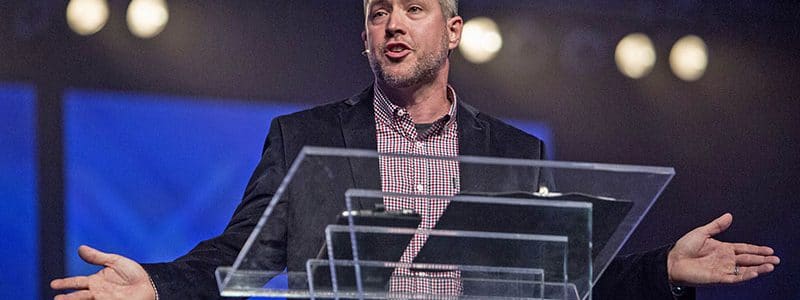DURHAM, N.C. A Jan. 31 simulcast for associational leaders will help launch Southern Baptist Convention President J.D. Greear’s “Who’s Your One?” evangelistic initiative among the 1,000-plus associations within the Southern Baptist network.
“Who’s Your One?” encourages every Southern Baptist to intentionally build a relationship with one person over the course of 2019, share the gospel and invite that person to trust Christ as Lord and Savior.
“Associations have always served as a valuable partner in cooperation, mobilizing churches together,” Greear, pastor of The Summit Church in Raleigh-Durham, N.C., told Baptist Press. “Our own local [Yates Baptist] Association, under the leadership of Marty Childers, provides a great structure for church revitalization, racial reconciliation and partnership evangelism in our city. It only seemed natural for every association in the country to work together.”
Sponsored by the North American Mission Board and the Yates Association, the simulcast will begin at 12:30 p.m. Eastern time on Jan. 31 and feature Greear’s introduction of “Who’s Your One?” to Yates Association pastors as they gather for a luncheon at Ridgecrest Baptist Church in Durham. Other associations that sign up online will receive login information to broadcast the event live.
Following Greear’s address, Johnny Hunt, NAMB’s senior vice president of evangelism and leadership, will introduce a “Who’s Your One?” evangelism kit being produced by NAMB for release in February. The kit is designed to help pastors lead a multi-week emphasis in their churches, encouraging every member to become more focused and intentional about evangelism.
Hunt told BP, “The ‘Who’s Your One?’ evangelism kit is going to be a huge help to pastors throughout our convention as they seek to mobilize their congregations for evangelism. Our associational leaders can play a key role in helping churches engage with this effort. We are grateful for their partnership and look forward to seeing how God is going to move as thousands of Southern Baptists become focused on sharing their faith.”
The simulcast also will feature a question-and-answer session with Greear, Hunt and Yates Association pastors.
Ray Gentry, executive director of the Southern Baptist Conference of Associational Leaders, has encouraged associations around the SBC to host their own pastors’ luncheons during the simulcast or show the event video, which will be archived, to pastors at a later gathering.
“The event is an opportunity for Pastor Greear to speak directly to our associations, recognizing the critical role associations play in equipping our churches for ministry,” Gentry wrote in a Dec. 20 email to associational leaders. “Can you imagine the impact if every church in our associations were filled with people asking God each day to allow them to lead one person to Christ this year?”
Childers, missional strategist for the Yates Association, called the simulcast “a great example of Baptist collaboration.”
“We’re excited to be on board with Who’s Your One?,” added Shane Pruitt, director of evangelism for the SBTC. He recalled a meeting in late November at NAMB with state convention evangelism directors and seminary professors where the idea was unveiled. “I am praising God for the focus on personal evangelism, and the collaboration taking place to put a continual focus on it. We are always better together than we are a part when it comes to proclaiming the gospel.”
Pruitt recalled examples of a Who’s Your One strategy two thousand years ago in the gospel narratives. “My favorite one is from John 1:43-46 when Jesus calls Philip to follow him, then immediately Philip goes after Nathaniel and invites him to ‘come and see.’”
Calling Nathaniel Philip’s “one,” Pruitt added, “Then, they both went and found other ones. That is how the kingdom is expanded. I love it. The SBTC Evangelism department will always be on board with anything that is biblically based, kingdom focused and missionary driven. May many come into the family of God through these efforts for the name, fame and glory of our King!” Additional information about the simulcast is forthcoming on the SBCAL website (sbcassociations.org) and SBCAL social media channels.












